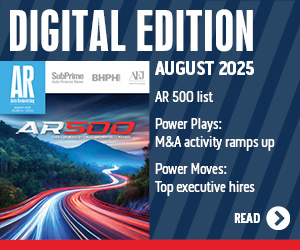Carvana files for $100M IPO

This past Friday, online used-vehicle retailer Carvana filed paperwork with the Securities and Exchange Commission for an initial public offering worth $100 million while also detailing how the company has performed since it began turning used metal through its “car-vending machines” and Internet channels more than four years ago.
Carvana highlighted that while revenue grew 180 percent year-over-year by the close of 2016, the company still is experiencing significant losses as the SEC filing indicated the 2016 net loss came in at $93.1 million.
During the three-year span from January 2013 through the end of 2016, Carvana said in the filing that it sold and delivered approximately 27,500 vehicles to customers through its website, generating $541.8 million in revenue. However, during that span, the total losses were $152.6 million.
As of the close of last year, Carvana operated in 21 metropolitan markets, adding two markets in 2014, six in 2015 and 12 in 2016. Philadelphia and San Antonio joined the network this year.
Much of Carvana’s IPO filing detailed the challenges the company is facing to set its footing in the used-vehicle retail space. The company recognized its growth could stall if it doesn’t generate several objectives, including:
—Increase the number of unique visitors to its website and the number of customers
—Further improve the quality of our product offering, features and complementary products and services, and introduce high quality new products, services and features
—Introduce additional third party products and services
—Acquire sufficient appropriate inventory at an attractive cost and high quality to meet the increasing demand for our vehicles
“There can be no assurance that we will meet these objectives,” Carvana said in the filing.
Perhaps what is driving Carvana’s net losses so far include what the company mentioned as areas it will continue to spend substantial financial and other resources, which include:
—Marketing and advertising, including an increase to in television advertising expenditures
—Expansion of our vehicle inventory
—General administration, including legal, accounting and other compliance expenses related to being a public company
Relationship with DriveTime
Furthermore, Carvana pointed out the important relationship it has with DriveTime, which had provided the online retailer with significant resources. Carvana went into significant detail about its connection to Drivetime where it made a “series of arrangements … that were not negotiated at arm’s length,” since DriveTime’s controlling shareholder also the father of Carvana chief executive officer Ernie Garcia.
Now it appears the linking of Carvana and DriveTime is being reduced.
“Currently, many services that DriveTime historically provided to us (including certain accounting, finance, legal, human resources, payroll and benefits, information technology, real estate and inventory purchasing) are now provided by alternative vendors or have been brought in-house. Consequently, certain of our historical costs may not accurately reflect our future costs to the extent that DriveTime no longer provides us with such services or refuses to continue doing so at currently contracted-for prices,” Carvana said in the IPO filing.
For example, Carvana noted that DriveTime built the online retailer’s existing inspection and reconditioning centers (IRCs) and now leases them back to Carvana.
“If we are unable to time-efficiently and cost effectively construct or acquire additional IRCs in the future, our production capacity may not be sufficient to satisfy customer demand,” Carvana said in the filing. “In addition, we lease most of our logistics hubs from DriveTime. If we cannot similarly lease space for logistics hubs in our future markets from DriveTime, we may not be able to expand into new markets as quickly as we have historically and we may incur additional costs in such expansion.”
Carvana went into more detail about adjusting its relationship with DriveTime
“We continue to engage DriveTime and its affiliates, and other entities controlled by our controlling shareholder, to provide us with certain services, including the administration of VSCs sold to our customers,” the company said. “We also continue to utilize DriveTime for certain information technology and tax systems and services. For example, we rely on DriveTime’s inventory management system and accounting system to support our revenue recognition process.
“Should DriveTime fail to adequately perform any of these services or maintain these systems, our financial condition and results of operations may be adversely affected. Additionally, DriveTime has in the past and may in the future purchase automotive finance receivables from us,” Carvana continued.
“DriveTime performs ongoing servicing and collections on automotive finance receivables originated by us before and after we sell such automotive finance receivables. If DriveTime is unwilling to enter into servicing arrangements in our future facilities on terms or at prices consistent with their historical prices or at all, our ability to sell such receivables may be adversely affected, and if DriveTime refuses to continue servicing and collecting on automotive finance receivables originated by us prior to our sale of the same to third parties, our ability to adequately prepare such receivables for sale may be adversely affected,” Carvana went on to say.
Also of note, Carvana divulged an interesting point about the future of DriveTime, which has traditionally retailed vehicles in the deep subprime space.
“DriveTime is currently in the process of evaluating strategic alternatives, including the potential sale of the company to interested third parties,” Carvana said in its filing. “If such a sale is completed, there can be no assurances that DriveTime will enter into any new agreements or arrangements, or extensions or renewals of existing agreements or arrangements, with us on the same or similar terms or at all.”
Carvana growth strategies
Carvana also reiterated five crucial components of its growth strategy to capture more retail sales and revenue. Those elements included:
—Increase sales through further penetration of existing markets: “We believe that our markets are at an early stage of growth when measured by market share. We plan to continue marketing and actively building our brand in existing markets by improving our operations, opening additional vending machines, increasing our inventory size and growing brand awareness,” Carvana said.
—Continue to enter key geographic markets: “We believe there is a substantial opportunity to utilize our capital-light expansion model and proven go-to-market strategy to enter additional markets by expanding our existing logistics network and advertising in those markets,” Carvana said.
—Continue to innovate and extend technology: “We believe that the complexity of the automotive retail transaction provides substantial opportunity for technology investment and that our leadership and continued growth will enable us to responsibly invest in further differentiating ourselves from competitors’ offerings,” Carvana said.
—Develop broad consumer awareness of its brand: “We intend to attract new customers through advertising, public relations and customer referrals. We also plan to build vending machines in additional markets to capitalize on the publicity they generate and believe our brand building efforts will be further enhanced once we are able to economically launch national advertising campaigns,” Carvana said.
—Develop new products: “We plan to leverage our platform to increase monetization opportunities by introducing new complementary products and services. The car purchasing and ownership cycle provides many opportunities to add value for our customers, and our technology and process automation knowledge position us well to provide these services in unique and differentiated ways,” Carvana said.


